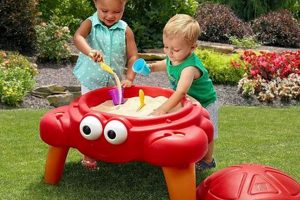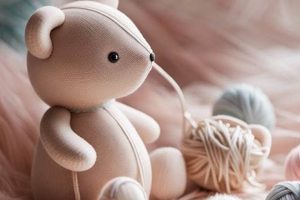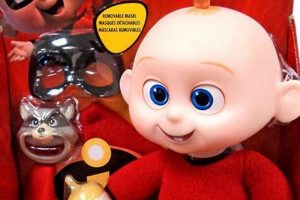Manufactured by Hape, these playthings are designed specifically for infants and toddlers. Constructed from sustainable materials, often wood and plant-based plastics, the items prioritize safety and developmental appropriateness. Examples include wooden blocks, stacking rings, and musical instruments tailored to little hands and emerging senses.
These products contribute significantly to early childhood development by fostering fine motor skills, hand-eye coordination, and cognitive abilities. The use of non-toxic finishes and durable construction ensures safety, while the eco-friendly materials appeal to environmentally conscious parents. The brand’s history demonstrates a commitment to creating stimulating and safe environments for play and learning.
The following sections will delve deeper into the specific categories, developmental benefits, and material safety considerations associated with these products, providing a comprehensive overview of their role in early childhood education and entertainment.
Guidance on Selecting Safe and Developmentally Appropriate Playthings for Infants
The following outlines key considerations when acquiring play items intended for babies, prioritizing safety and fostering age-appropriate development.
Tip 1: Material Safety: Scrutinize materials for non-toxic certifications. Ensure finishes are lead-free and phthalate-free. Prioritize items crafted from sustainably sourced wood or plant-based plastics.
Tip 2: Age Appropriateness: Adhere strictly to manufacturer-recommended age ranges. Items designed for older children may present choking hazards or contain small, detachable parts unsuitable for infants.
Tip 3: Durability and Construction: Select robustly constructed items capable of withstanding repeated use. Examine seams and joints for secure fastening to prevent breakage and potential hazards.
Tip 4: Sensory Stimulation: Prioritize items that engage multiple senses, such as textured blocks, brightly colored rattles, and musical instruments with varying tones. Such engagement supports cognitive development.
Tip 5: Developmental Appropriateness: Choose items that align with the infant’s current developmental stage. For example, simple grasp toys are suitable for younger infants, while stacking cups and shape sorters cater to more advanced motor skills.
Tip 6: Ease of Cleaning: Play items should be easily cleaned and sanitized to minimize the risk of germ transmission. Opt for items that can be wiped down with a damp cloth or are machine washable.
Tip 7: Supervised Play: Even with carefully selected items, continuous adult supervision remains paramount. Active monitoring minimizes the risk of accidents and allows for interactive engagement.
Adhering to these guidelines ensures the acquisition of play items that are both safe and conducive to optimal infant development. Prioritizing these factors contributes to a stimulating and secure play environment.
The subsequent section will examine specific product lines and their features in greater detail, providing a practical overview of available options.
1. Sustainable Material Sourcing
Sustainable material sourcing forms a foundational pillar in the production of Hape baby toys. This is characterized by the selection of resources that minimize environmental impact, conserve biodiversity, and support responsible forestry practices. A primary example is the utilization of bamboo, a rapidly renewable resource, in place of traditional hardwoods for certain toy components. The cause-and-effect relationship is clear: adopting sustainable sourcing directly reduces deforestation, lowers carbon emissions associated with transportation, and lessens the reliance on non-renewable resources. This is an important consideration in maintaining ecological integrity and minimizing long-term consequences of production.
The integration of Forest Stewardship Council (FSC)-certified wood constitutes another critical aspect of this approach. FSC certification ensures that the wood originates from responsibly managed forests adhering to stringent environmental and social standards. This demonstrates a commitment to ethical sourcing and responsible resource management. The practical significance of sustainable material sourcing extends beyond environmental benefits. Toys manufactured from sustainable materials are often perceived as higher quality and safer, aligning with growing consumer demand for eco-conscious products. By implementing this strategy, the company enhances its brand reputation and fosters customer loyalty.
While challenges such as higher initial material costs and the need for robust supply chain verification exist, the long-term advantages of sustainable material sourcing outweigh the drawbacks. This commitment aligns with broader global initiatives aimed at mitigating climate change, preserving natural resources, and promoting corporate social responsibility. The integration of sustainable material sourcing into production practices marks a shift toward a more ecologically responsible and ethically sound approach to manufacturing baby and children’s products.
2. Non-Toxic Finishes
The application of non-toxic finishes to playthings intended for infants and toddlers is of paramount importance. These finishes directly influence product safety and mitigate potential health risks associated with ingestion or prolonged contact.
- Water-Based Paints and Lacquers
Water-based paints and lacquers are commonly employed as alternatives to solvent-based counterparts. These formulations utilize water as the primary solvent, significantly reducing the emission of volatile organic compounds (VOCs). Lower VOC levels contribute to improved air quality and minimize potential respiratory irritation or other adverse health effects for children. The adoption of water-based finishes aligns with stringent environmental regulations and reflects a commitment to sustainable manufacturing practices within the industry.
- Plant-Based Oils and Waxes
Certain manufacturers utilize plant-based oils and waxes as natural alternatives to synthetic coatings. These materials, derived from renewable resources, provide a protective layer while minimizing the introduction of potentially harmful chemicals. Plant-based finishes can offer a distinct tactile experience and aesthetic appeal. It is essential to verify that the specific plant-based oil or wax used has undergone rigorous testing and complies with relevant safety standards for children’s products.
- Absence of Heavy Metals and Phthalates
The exclusion of heavy metals, such as lead, cadmium, and mercury, is a critical characteristic of non-toxic finishes. These heavy metals are known neurotoxins and pose significant health risks to developing children. Similarly, the avoidance of phthalates, a class of plasticizers often used to enhance flexibility, is essential. Phthalates have been linked to endocrine disruption and other adverse health outcomes. Reputable manufacturers conduct comprehensive testing to ensure their finishes are free from these harmful substances.
- Third-Party Certifications
Independent third-party certifications, such as those offered by GREENGUARD or similar organizations, provide assurance that a finish has been rigorously tested and meets specific standards for chemical emissions and safety. These certifications offer consumers a means of verifying product claims and making informed purchasing decisions. Reliance on reputable certification programs enhances transparency and accountability within the industry.
The selection and application of non-toxic finishes are integral to the responsible manufacturing of children’s products. A commitment to utilizing safe and environmentally sound materials is essential for safeguarding the health and well-being of infants and toddlers.
3. Developmental Appropriateness
Developmental appropriateness serves as a core design principle for Hape baby toys, influencing material selection, construction, and overall functionality. Failure to align a toy with an infant’s developmental stage can negate its intended benefits and, in some cases, pose safety hazards. The cause-and-effect relationship is direct: a toy designed for a two-year-old presents choking risks to a six-month-old due to smaller parts and more complex functionalities. Hape addresses this by categorizing its products by age range, ensuring that each toy aligns with the corresponding cognitive and motor skill capabilities. For instance, simple rattles and grasp toys are designed for early infancy, promoting hand-eye coordination and sensory exploration. As infants develop, stacking cups and shape sorters introduce problem-solving skills and fine motor control, matching their evolving capabilities.
The significance of developmental appropriateness extends beyond mere safety. Toys designed for a specific developmental stage can effectively stimulate learning and promote the acquisition of new skills. For example, Hape’s musical instruments for babies, such as xylophones and shakers, introduce basic concepts of cause and effect as infants learn to manipulate the instruments and produce different sounds. This early exposure to music can foster auditory processing skills and creativity. Similarly, Hape’s wooden blocks, designed for toddlers, encourage spatial reasoning and problem-solving as children stack, arrange, and build structures. The act of manipulating these blocks enhances fine motor skills and promotes cognitive development. The practical application of this understanding informs parental choices, allowing them to select toys that optimally support their child’s growth and development.
In summary, developmental appropriateness is not merely a secondary consideration but a primary driver in the design and manufacturing of Hape baby toys. Its importance lies in ensuring safety, promoting effective learning, and fostering the acquisition of age-appropriate skills. While challenges may exist in accurately assessing individual developmental variations, adherence to established developmental milestones and age-appropriate design principles enables the creation of toys that contribute positively to a child’s early development. This approach underscores the company’s commitment to producing safe, stimulating, and developmentally appropriate products for infants and toddlers.
4. Durable Construction
Durable construction is a critical attribute of Hape baby toys, influencing product longevity, safety, and overall value. The inherent cause-and-effect relationship is evident: inferior construction leads to premature product failure, potentially exposing infants to hazards and negating the intended developmental benefits. The practical significance of this understanding stems from the fact that infants and toddlers often subject toys to rigorous handling, including dropping, throwing, and chewing. A toy designed for sustained use can withstand these stresses without compromising its structural integrity. Hape toys employ robust joinery methods, such as doweling and screwing, combined with high-quality materials, like sustainably sourced wood, to ensure resistance to damage. The use of non-toxic, durable finishes further contributes to product longevity, preventing chipping or peeling that could pose choking hazards.
The importance of durable construction extends beyond basic safety concerns. Toys that withstand repeated use and retain their functionality offer superior value. This is particularly relevant in the context of early childhood development, where consistent engagement with a given toy can reinforce learning and promote skill development. A Hape wooden block set, for instance, constructed with precisely cut and sanded blocks, maintains its shape and stability over time, enabling children to build complex structures and experiment with spatial relationships. The durable nature of these blocks facilitates repeated play sessions, maximizing the opportunities for cognitive and motor skill development. Similarly, Hape’s musical instruments, built with sturdy components and secure fastenings, withstand the percussive forces applied during use, providing children with a reliable and engaging musical experience. This ensures the instrument’s long-term usability and maximizes its value as a developmental tool.
In summary, durable construction is not merely a design feature but a fundamental prerequisite for Hape baby toys. It directly impacts product safety, longevity, and developmental effectiveness. While the implementation of robust construction techniques may necessitate increased manufacturing costs, the long-term benefits, including enhanced product value and reduced risk of injury, outweigh the initial investment. This commitment to durability aligns with the broader themes of sustainability and responsible manufacturing, reflecting Hape’s dedication to creating safe, high-quality products that contribute positively to a child’s early development.
5. Sensory Stimulation
Sensory stimulation is a foundational element in the design and function of products for infants, particularly within the context of Hape’s product line. The objective is to provide stimuli that engage the developing senses of sight, sound, touch, and, to a lesser extent, smell and taste (through safe, non-toxic materials designed for mouthing). The cause-and-effect relationship is discernible: targeted sensory input fosters neural connections, impacting cognitive and motor skill development. For example, Hape’s brightly colored rattles and textured blocks generate visual and tactile stimulation. The presence of diverse colors aids in visual discrimination skills, while varying textures promote tactile exploration and sensory integration. Sounds produced by toys enhance auditory processing and stimulate interest in cause-and-effect relationships (e.g., shaking a rattle produces a sound). The practical importance is that these sensory experiences lay the groundwork for cognitive development.
The integration of sensory features extends beyond individual product design. Hape offers a range of musical instruments suitable for infants, such as xylophones and tambourines. These instruments provide auditory stimulation, promote rhythmic awareness, and encourage exploration of musical concepts. The use of varying materials, such as wood and metal, further enhances the tactile experience and auditory variety. Hape’s range of wooden blocks often incorporates textures and varied shapes, moving beyond basic geometric forms to introduce complex tactile sensations and promote spatial reasoning. The practical application of this sensory-rich design is an enhanced capacity for learning and adaptation. Toys with carefully chosen sensory components encourage sustained engagement, creating learning opportunities that promote intellectual growth.
In summation, the effective integration of sensory stimulation is not an optional add-on but a vital ingredient in the development of Hape baby toys. The deliberate design choices that incorporate diverse stimuli contribute directly to cognitive and motor skill development, with the products designed to engage specific sensory modalities in a safe and developmentally appropriate manner. While individual sensory preferences vary, the fundamental goal is to create enriching play experiences that stimulate curiosity, encourage exploration, and support the infant’s overall development. This aligns with the broader theme of creating sustainable and ethically responsible products for early childhood education.
Frequently Asked Questions About “Hape Baby Toys”
The following addresses common inquiries regarding the safety, materials, and developmental benefits associated with infant and toddler play items manufactured by Hape.
Question 1: Are Hape baby toys manufactured using sustainable materials?
Hape prioritizes the use of sustainable materials, including bamboo and FSC-certified wood, in the production of its toys. This commitment aligns with environmentally responsible manufacturing practices.
Question 2: What safety standards do Hape baby toys adhere to?
Hape products undergo rigorous testing to meet or exceed international safety standards, including EN71 and ASTM. These standards ensure that the toys are free from harmful chemicals and pose minimal physical risks.
Question 3: Are the paints and finishes used on Hape baby toys non-toxic?
Hape exclusively utilizes non-toxic, water-based paints and finishes on its products. These materials are free from lead, phthalates, and other harmful substances, ensuring safety for infants and toddlers.
Question 4: What age range are Hape baby toys designed for?
Hape categorizes its products by age range, typically from birth to three years. Each product is designed to align with the developmental milestones and capabilities of children within the specified age group.
Question 5: How should Hape baby toys be cleaned and maintained?
Most Hape toys can be cleaned with a damp cloth and mild soap. Avoid immersing wooden toys in water or using harsh cleaning agents. Regular inspection for damage is also recommended.
Question 6: Where can Hape baby toys be purchased?
Hape products are available through various retailers, including online marketplaces, specialty toy stores, and department stores. Verify the authenticity and safety certifications of the product when purchasing from third-party vendors.
In summary, products provide safe and developmentally appropriate play experiences due to sustainable practices and adherence to rigorous testing procedures.
The next section will examine real-world case studies and applications of products in early childhood settings.
Conclusion
The exploration of “Hape baby toys” reveals a consistent emphasis on safety, sustainability, and developmental appropriateness. From material sourcing to product design, a commitment to creating stimulating and secure play environments for infants and toddlers is evident. The use of non-toxic finishes, durable construction techniques, and thoughtfully selected sensory elements contribute to the products’ value in early childhood development.
Continued adherence to rigorous safety standards, alongside ongoing innovation in sustainable material usage and developmentally targeted design, will define the future trajectory. The importance of informed purchasing decisions, prioritizing both safety and developmental appropriateness, remains paramount in supporting optimal outcomes for young children.







